Big Ideas Math Integrated Math Chapter 6 Maintaining Mathematical Proficiency
Page 157 Exercise 1 Problem 1
Question 1.
Given the expression 8 ÷ 4.19 + 18 + 13, simplify it according to the order of operations (BODMAS/BIDMAS rule). show all steps and calculations clearly.
Answer:
The given expression 8 ÷4.19 + 18 + 13 is to be simplified as per the order of precedence of mathematical operators stated in “BODMAS” rule.
Here, we will first perform division, then multiplication, and finally addition.
Rewriting the given expression
⇒ 8 ÷4.19 + 18 + 13
Upon division, we get
⇒ 2.19 + 18 + 13
Multiplication follows
⇒ 38 + 18 + 13
Finally adding them, we get
⇒ 69
Upon evaluation of the expression 8 ÷ 4.19 + 18 + 13, as per the precedence of operations stated by the “BODMAS” rule, we get 69 as the answer.
Page 157 Exercise 2 Problem 2
Question 2.
Given the expression 3.14.11 + 42 + 19, simplify it according to the order of operations (PEMDAS/BODMAS rule) show all the steps and calculations clearly.
Answer:
Given
The expression 3.14.11 + 42 + 19
Here, we have to evaluate the given expression as per the”PEMDAS” rule.
We will solve it as per the order of operations stated in this rule.
The expression given in the question is
⇒ 3.14.11 + 42+ 19
Solving the exponent first, we get
⇒ 3.14.11 + 16 + 19
Performing multiplication, we get
⇒ 462 + 16 + 19
Adding them all, we get
⇒ 497
Simplifying the expression 3.14.11 + 42 + 19 as per the “PEMDAS” rule, the answer is evaluated as 497.
Page 157 Exercise 3 Problem 3
Question 3.
Given the expression (21 + 2)(14-6) + 32, simplify it according to the order of operations (PEMDAS/BODMAS rule). show all the steps and calculations clearly.
Answer:
Given
The expression (21 + 2)(14-6) + 32
Here, we have to evaluate the given expression as per the“PEMDAS” rule.
We will solve it as per the order of operations stated in this rule.
We rewrite the given expression
⇒ (21 + 2)(14−6) + 32
Solving both the parenthes is, we get
⇒ 23.8 + 32
Now, solving the exponents, we get
⇒ 23.8 + 9
Now, performing multiplication, we get
⇒ 184 + 9
Finally, upon adding, we get
⇒ 193
Upon simplification of the expression given as (21 + 2)(14−6) + 32 as per the “PEMDAS” rule, the answer is evaluated as 193.
Page 157 Exercise 4 Problem 4
Question 4.
Explain the zero exponent rule and use it to evaluate the expression 640. Provide a detailed proof and an example to illustrate the rule.
Answer:
Proof Of Zero Exponent Rule- Consider an exponential term am.
We divide it by the same exponential term, and find the quotient.
Mathematically, we can write
⇒ \(\frac{a^m}{a^m}\)
Both cancel out each other and we get 1 as our result.
But, by the rule of exponents, we have a(m−m) = a0.
Thus, from here we observe that a0 = 1
Here, we need to evaluate the exponential expression given in the question.
The expression has two components viz; the base 64 and the exponent 0.
The complete expression is called as power which is often confused with exponent.
We will make use of the rule of zero exponent and evaluate the given expression.
Applying the rule of zero exponent in the expression, we have
⇒ 640
= 1
The expression is 640 evaluated out to be 1.
Page 157 Exercise 5 Problem 5
Question 5.
Explain how to evaluate the exponential expression (4)− 2. Provide a detailed explanation using the rules of exponents and show each step of the calculation. What is the value of 4− 2?
Answer:
Given
(4)− 2.
Here, we are asked to evaluate the exponential expression(4)− 2
The expression has the base as 4
and has a negative exponent i.e(−2).
Since it is in the numerator, we need to flip it down to the denominator to make the complete expression evaluable.
We can rewrite the given expression in the following form
⇒ (4)− 2 = \(\frac{1}{(4)^2}\)
⇒ (4)− 2 = \(\frac{1}{(-4) \times(-4)}\)
⇒ (4)− 2 = \(\frac{1}{16}\)
The expression 4–2 is evaluated out to be \(\frac{1}{16}\).
Page 157 Exercise 6 Problem 6
Question 6.
Explain how to evaluate the exponential expression (-3)-3. Provide a detailed explanation using the rules of exponents and show each step of the calculation. What is the value of (-3)-3?
Answer:
We are given the exponential expression as(−3)-3.
Here the base and its exponent both are the same i.e.−3.
In order to evaluate this expression, since it is in the numerator, we need to turn it down to the denominator.
We can rewrite the expression given in an evaluable form as
⇒ (−3)−3 = \(\frac{1}{(-3)^3} \)
⇒ (−3)−3 = \(\frac{1}{(-3) \times(-3) \times(-3)} \)
⇒ (−3)−3 = \(\frac{1}{−27}\)
⇒ (−3)−3 = \(\frac{1}{−27}\)
The expression(−3)−3 is evaluated out to be \(\frac{1}{−27}\).
Page 157 Exercise 7 Problem 7
Question 7.
Evaluate the exponential expression 70+ 5− 2. Use the rule for zero exponents, negative exponets, and positive exponents to simplify the expression step-by-step. What is the final value of the expression?
Answer:
The given exponential expression is 70+ 5− 2
Use zero exponential, negative exponential, positive exponential method Evaluate the expression
The given expression is 70+ 5− 2
= 1 + \(\frac{1}{5^2}\)
= 1 + \(\frac{1}{25}\)
= \(\frac{26}{25}\)
The evaluation of the expression 70 + 5− 2 is \(\frac{26}{25}\)
Page 157 Exercise 8 Problem 8
Question 8.
Evaluate the exponential expression (−2)−6⋅80. Use the rules for zero exponents, negative exponents, and positive exponents to simplify the expression step-by-step. What is the final value of the expression?
Answer:
The given exponential expression is (−2)−6⋅80
Use zero exponential, negative exponential, positive exponential method
Evaluate the expression
The given exponential expression is (−2)−6 ⋅80 (−2)−6⋅80
= \(\frac{1}{-2^6} \cdot 8^0\)
= \(\frac{1}{64}\) . 1
= \(\frac{1}{64}\)
The evaluation of the expression (−2)−6 ⋅80 is \(\frac{1}{64}\)
Page 157 Exercise 9 Problem 9
Question 9.
Evaluate the exponential expression 73 .7−3. Use the rules for zero exponents, negative exponents, and positive exponents to simplify the expression step-by-step. What is the final value of the expression?
Answer:
The given exponential expression is 73 .7−3
Use zero exponential, negative exponential, positive exponential method
Evaluate the expression
The given exponential expression is 73 . 7−3
= 73. \(\frac{1}{7^3}\)
= \(\left(\frac{7}{7}\right)^3\)
= 13
= 1
The evaluation of the expression 73⋅7−3 is 1
Page 157 Exercise 10 Problem 10
Question 10.
Evaluate the exponential expression 6−2 ÷ 19 . 9. Use the rules for zero exponents, negative exponents, and positive exponents to simplify the expression step-by-step. What is the final value of the expression?
Answer:
The given exponential expression is 6−2 ÷ 19 . 9
Use zero exponential, negative exponential, positive exponential method
Evaluate the expression
The given exponential expression is
= \(\frac{1}{6^2} \times \frac{1}{1^9} \cdot 9\)
=\(\frac{1}{36}\). 1. 9
= \(\frac{1}{4}\)
The evaluation of the expression 6−2 ÷ 19 . 9 is \(\frac{1}{4}\)
Page 157 Exercise 11 Problem 11
Question 11.
Given the arithmetic sequence 1,5,9,13, …, find the formula for the nth term of the sequence. Use the formula an = a + (n−1)d to determine the expression for the nth term. What is the nth term of the sequence?
Answer:
The given arithmetic sequence is
1,5,9,13………
Using the formula of the arithmetic sequence
an = a + (n−1)d
The common difference d = b − a
b = 5, a = 1
d = 5−1 d = 4
The nth term is
an = 1 + (n−1)4
an= 4n − 3
The nth term of 1,5,9,13,…. is an = 4n − 3
Page 157 Exercise 12 Problem 12
Question 12.
Given the arithmetic sequence 21, 15, 9, 3, …, find the formula for the nth term of the sequence. Use the formula an = a + (n – 1) d to determine the expression for the nth term. What is the nth term of the sequence?
Answer:
The given arithmetic sequence is
21,15,9,3……
Using the formula of the arithmetic sequence
an = a + (n – 1) d
The common difference d = b − a
d = 15 − 21
d = − 6
The nth term is
an = 21 + (n−1)(−6)
= 21 + 6−6n
an = 27−6n
The nth term of the sequence 21,15,9,3,… is 27−6n
Page 157 Exercise 13 Problem 13
Question 13.
Given the arithmetic sequence -2, 1, 4, 7, …, find the formula for the nth term of the sequence. Use the formula an = a+(n-1)d to determine the expression for the nth term. What is the nth term of the sequence?
Answer:
The given arithmetic sequence is
−2,1,4,7……
Using the formula of the arthmetic sequence
an = a+(n-1)d
The common difference
d = b − a
d = 1−(−2)
d = 3
The nth term of the sequence is
an =−2 + (n−1)3
= −2 + 3n − 3
= 3n − 5
The nth term of the sequence −2,1,4,7,… is 3n−5
Page 157 Exercise 14 Problem 14
Question 14.
Given the arithmetic sequence -10, -4, 2, 8, …, find the formula for the nth term of the sequence. Use the formula an = a+(n-1)d to determine the expression for the nth term. What is the nth term of the sequence?
Answer:
The given arithmetic sequence is
−10,−4,2,8……
Using the formula of the arthmetic sequence
an = a+(n-1)d
The common difference
d = b−a
= −4 + 10
d = 6
The nth term of the sequence is
an = −10 + (n−1)(6)
= −10−6 + 6n
= 6n−16
The nth term of the sequence −10,−4,2,8,… is 6n−16
Page 158 Exercise 15 Problem 15
Question 15.
What are the key characteristics of an exponential function?
Describe the properties of its graph, including the points it passes through, the domain and range, the behavior as x approaches positive and negative infinity, and other relevant features.
Answer:
The characteristics of the exponential function are
The graph passes through the point (0,1).
The domain is all real numbers
The range is y > 0
The graph is increasing
The graph is asymptotic to the x-axis as x approaches negative infinity
The graph increases without bound as x approaches positive infinity
The graph is continuous
The graph is smooth
These are the characteristics of the exponential function
Page 159 Exercise 16 Problem 16
Question 16.
Given the exponential functions y = 16(2)x and y = 16(\(\left(\frac{1}{2}\right)^x\), describe the process for sketching these graphs. Identify key points used for plotting each graph and explain the symmetry observed around the y-axis.
What are the steps to determine specific points for plotting, and what does this symmetry indicate about the relationship between these two functions?
Answer:

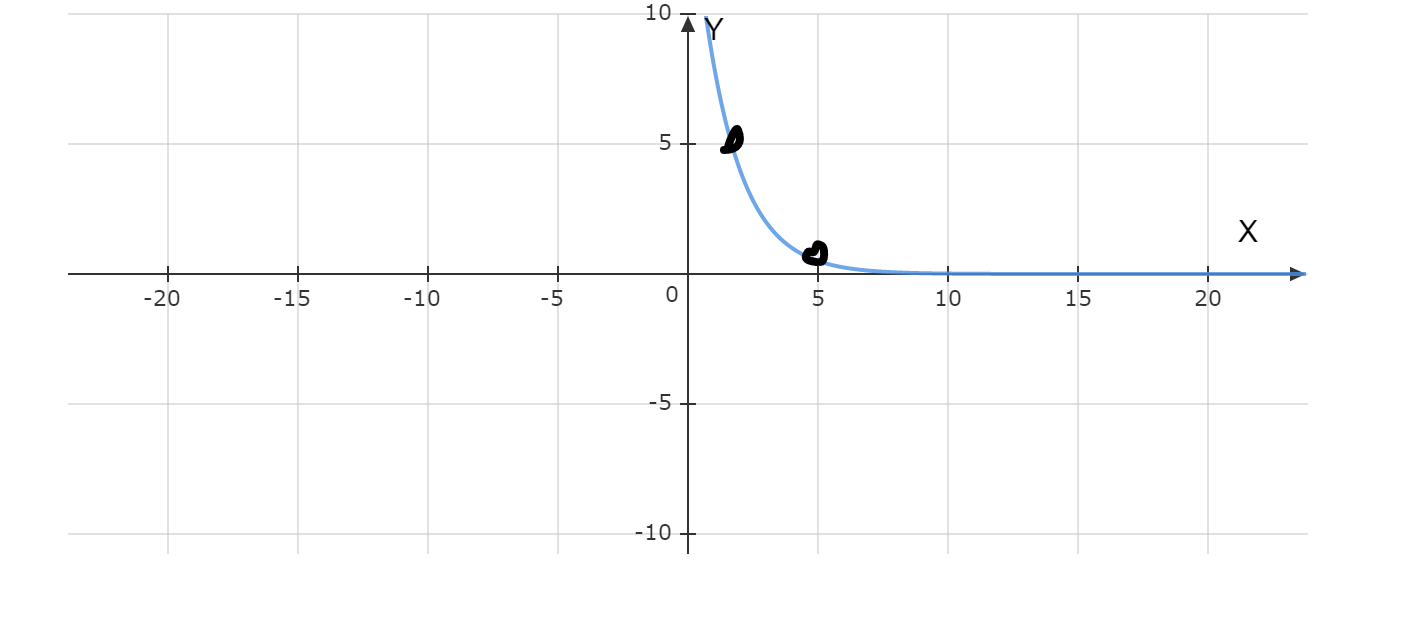
We sketch the graph of y=16(2)x and
y=16\(\left(\frac{1}{2}\right)^x\) as shown above.
We sketch first graph using points x = −5 and y = 0.5
Also y = 5
For x = −1.67
We plot second graph using points x = 5
y = 0.5
Also,y = 5
x = 1.67
We find points to plot first graph y = 16(2)x
For x = −5
y = 16(2)−5
y = 0.5
Also, when y=5
x = \(\frac{\log \frac{5}{16}}{\log 2}\)
We now plot second graph y 16(\(\left(\frac{1}{2}\right)^x\) using points
x = 5
y = \(16\left(\frac{1}{2}\right)^5\)
y = 0. 5
When y = 5
x = \(\frac{\log \frac{5}{16}}{\log \frac{1}{2}}\)
x = 1.67
Both the graphs are symmetric around Y axis


We plotted graph using few points like
First graph (−5,0.5) ,(−1.67,5)
Second graph (5,0.5),(1.67,5)
Graph is symmetric around Y axis
Page 159 Exercise 17 Problem 17
Question 17.
Given the exponential function y = 2x, sketch the graph and describe its characteristics. Identify the key points used for plotting the graph and explain the behavior of the function as x approaches both negative and positive infinity.
What does the behavior of the function indicate about the relationship between the input x and the output y?
Answer:
The given expression is y = 2x
The characteristics of the given expression are
The graph passes through the point (0,1).
The domain is all real numbers
The range is y > 0
The graph is increasing
The graph is asymptotic to the x-axis as x approaches negative infinity
The graph increases without bound as x approaches positive infinity
The graph is continuous
The graph is smooth
The graph of the given expression y = 2x is
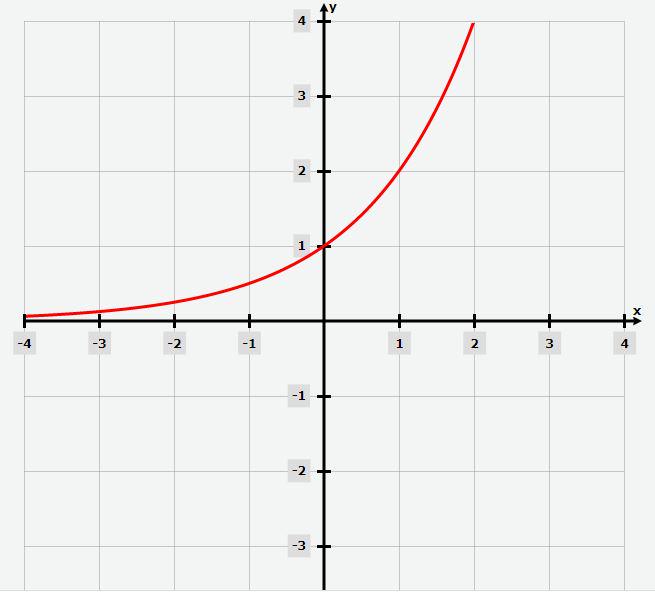
Page 159 Exercise 17 Problem 18
Question 18.
Given the exponential function y = 2.(3)x, sketch the graph and describe its characteristics. Identify the key points used for plotting the graph and explain the behavior of the function as x approaches both negative and positive infinity.
What does the behavior of the function indicate about the relationship between the input x and the output y?
Answer:
The given expression is y = 2.(3)x
The characteristics of the given expression are
The graph passes through the point (0,2).
The domain is all real numbers
The range is y > 0
The graph is increasing
The graph is asymptotic to the x-axis as x approaches negative infinity
The graph increases without bound as x approaches positive infinity
The graph is continuous
The graph is smooth
The graph of given expression is
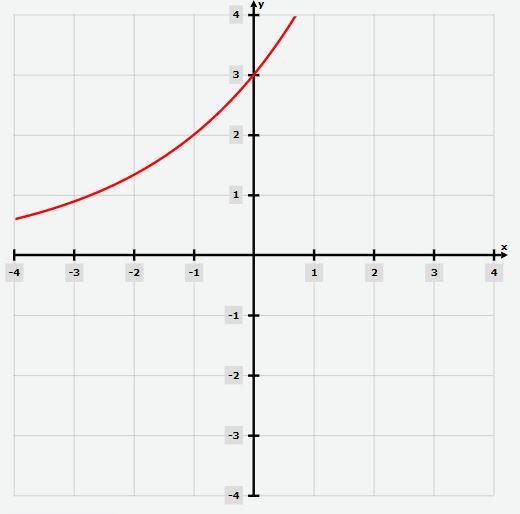
Page 159 Exercise 17 Problem 19
Question 19.
Given the exponential function y = 3⋅(1.5)x, sketch the graph and describe its characteristics. Identify the key points used for plotting the graph and explain the behavior of the function as x approaches both negative and positive infinity.
What does the behavior of the function indicate about the relationship between the input x and the output y?
Answer:
The given expression is y = 3⋅(1.5)x
The characteristics of the given expression are
The graph passes through the point (0,3).
The domain is all real numbers
The range is y > 0
The graph is increasing
The graph is asymptotic to the x-axis as x approaches negative infinity
The graph increases without bound as x approaches positive infinity
The graph is continuous
The graph is smooth
The graph of given expression is
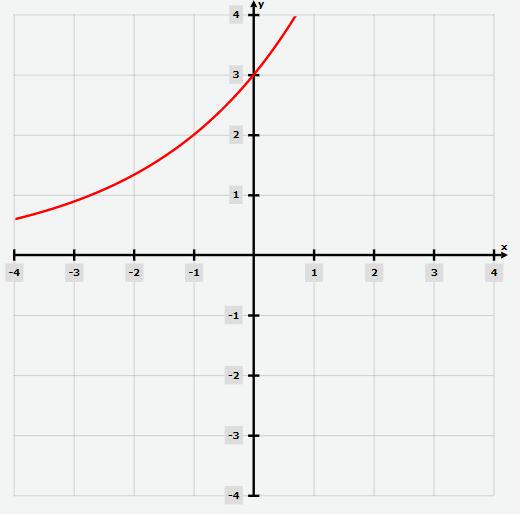
Page 161 Exercise 18 Problem 20
Question 20.
Assume the given table represents an exponential function of the form y = abx.
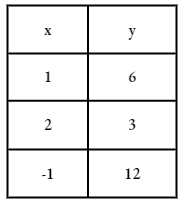
Using the given values for x and y in the table, determine the values of a and b for the exponential function.
Verify if the determined exponential function satisfies all the given points in the table, particularly checking y for x = -1.
Answer:
We assume the table represents an exponential
Function y = abx
We substitute y = 6
For x = 1
Thus we get an expression in a and b
Now we substitute y = 3
For x = 2
Thus we solve the equation for a and b
We get an exponential equation
We check the equation for y using x = −1
Lets assume that table represents an exponential equation y = abx
From table y = 6
For x = 1
Thus ab = 6
From table y = 3
For x = 2
We substitute in exponential function
3 = abb
3 = 6.b
b =\(\frac{1}{2}\)
We substitute b
a .\(\frac{1}{2}\) = 6
a = 12
The exponential function is y = 12\(\left(\frac{1}{2}\right)^x\)
We check the above equation for x = −1
y = 12\(\left(\frac{1}{2}\right)^{-1}\)
y = 24
y ≠ 12
Thus table doesn’t represent any exponential function
y = 12\(\left(\frac{1}{2}\right)^x\) doesn’t satisfy x = −1 for y = 12 Thus table doesn’t represent exponential function
Page 161 Exercise 19 Problem 21
Question 21.
Assume the given table represents an exponential function of the form y=abx.
\(\begin{array}{|l|l|}\hline x & y \\
\hline-1 & 0.5 \\
\hline 0 & 1 \\
\hline 1 & 2 \\
\hline 2 & 8 \\
\hline
\end{array}\)
- Using the given values for x and y in the table, determine the values of a and b for the exponential function.
- Verify if the determined exponential function satisfies all the given points in the table, including additional points such as x=−1 and x=0.
Answer:
We assume table represents an exponential
Function y = abx
We substitute y = 2
For x = 1
Thus we get an expression in a and b
Now we substitute y = 8
For x = 2
Thus we solve the equation for a and b
We get an exponential equation
Lets assume that table represents an exponential equation y = abx
From table y = 2
For x = 1
Thus ab = 2
From table y = 8
For x = 2
We substitute in exponential function
8 = abb
8 = 2.b
b = 4
We substitute b
a.4 = 2
a = \(\frac{1}{2}\)
y = \(\frac{1}{2}\)(4)x
It also satisfy x = −1 and x = 0
Table represents an exponential functiony = \(\frac{1}{2}\)(4)x
Page 161 Exercise 20 Problem 22
Question 22.
Given the exponential function y = 3x:
- Substitute x=5 into the function to find the value of y.
- Write the resulting value of y as the function evaluated at x=5.
Answer:
We write given equation as y = 3x
We substitute x = 5
We get y by solving above equation
We thus write solved function
We write given equation y = 3x
We substitute x = 5
y = 35
Thus function is y = 243
Function for given value of x is y = 243
Page 161 Exercise 21 Problem 23
Question 23.
Given the equation y=(14)-x:
- Substitute x=3 into the equation and solve for y.
- Verify the value of y obtained by showing all the steps.
- State the function with the substituted value of x and the corresponding value of y.
Answer:
We write given equation as y = \(\left(\frac{1}{4}\right)^x\)
We substitute x = 3
We get y by solving above equation
We thus write solved function
We write given equation y = \(\left(\frac{1}{4}\right)^x\)
We substitute x = 3
y = \(\left(\frac{1}{4}\right)^3\)
Thus function is y = 0.0156
Function for given value of x is y = 0.0156
Page 161 Exercise 22 Problem 24
Question 24.
Given the equation y=3(4)x:
- Substitute x=4 into the equation and solve for y.
- Verify the value of y obtained by showing all the steps.
- State the function with the substituted value of x and the corresponding value of y.
Answer:
We write given equation as y = 3(4)x
We substitute x = 4 in above equation
We get y by solving above equation
We thus write solved function
We write given equation y = 3(4)x
We substitute x = 4
y = 3(4)4
Thus function is y = 768
Function for given value of x is y = 768
Page 162 Exercise 23 Problem 25
Question 25.
Consider an exponential function of the form y=abx represented by a graph. Based on the graph, the following points are known:
- When x = 0, y = -0.5
- When x = -0.5, y = -1
- When x = -1, y = -2
- Using the point where x=0, determine the value of a.
- Using the point where x = −0.5, determine the value of b.
- Verify the function with the point where x=−1.
- Write the exponential equation representing the graph.
Answer:
We assume table represents an exponential function is y = abx
We substitute y = −0.5
From graph
x = 0
Thus we get an expression in a
Now we substitute y = −1
From graph
For x = −0.5
Thus we get expression in a and b
We check the above equation for y =−2
From graph
For x = −1
Lets assume the graph represents exponential equation
y = abx
From graph y =−0.5
For x = 0
a = −0.5
We substitute y = −1 from graph
For x = −0.5
−1 = (−0.5)b−0.5
b = \(\frac{1}{4}\)
The exponential equation is y = (−0.5)(\(\frac{1}{4}\))x
We check the above equation for x = −1 from graph
y = (−0.5)(\(\frac{1}{4}\))−1
y = −2
Hence graph represents exponential function y = (−0.5)(\(\frac{1}{4}\))x
Graph represents exponential equation y = (−0.5)(\(\frac{1}{4}\))x
Page 163 Exercise 24 Problem 26
Question 26.
Explain the characteristics of exponential growth and decay functions by answering the following:
- Define an exponential growth function and provide a real-world example.
- Define an exponential decay function and provide a real-world example.
- Write the general form of both exponential growth and decay functions.
- Explain the role of the constant r in the function f(x)=a(1+r)x.
- Describe the behavior of exponential growth and decay functions in terms of increasing or decreasing nature.
Answer:
We have to explain the characteristics of an exponential growth and decay functions.
We will first define both the functions and then give their salient characteristics.
An exponential growth function is a function in which the value of the function increases by a fixed percentage on every increment of x.
Compound interest calculation are a type of exponential growth function.
An exponential decay function is a function whose value decreases by a fixed percentage on every increment of x.
Radioactivity and half life are the example of exponential decay functions.
Both the exponential growth and decay functions defined as:
f (x) = a (1 + r)x
Here r can be positive or negative depending on whether the function is growth or decay function.
It is the percent change in decimal form and a is a constant and is the vertical intercept of the graph.
The exponential growth function is an increasing function while the exponential decay function is a decreasing function.
We have thus explained the exponential growth and decay functions along with their definitions and characteristics.
Page 164 Exercise 25 Problem 27
Question 27.
A body initially had a temperature of 80.5°F, while the room temperature was 60°F. After one hour, the body temperature decreased to 78.5°F. Calculate the percentage decrease of the difference between the body temperature and the room temperature in one hour.
- Calculate the initial difference (DI) between the body temperature and the room temperature.
- Calculate the final difference (DF) between the body temperature and the room temperature after one hour.
- Determine the change (C) in the difference between the initial and final temperatures.
- Compute the percentage decrease (P) from the initial difference (DI) to the final difference (DF).
Answer:
We have to calculate the percentage decrease of the difference between the body and the room temperature in one hour.
The temperature earlier was 80.5° F while the room temperature was 60° F
The temperature became 78.5°F
The difference initially between the body and the room temperature is given by
DI = 80.5−60
DI = 20.5
The final difference is given by
DF = 78.5−60
DF = 18.5
Change in the initial and final difference
C = 20.5−18.5
C = 2
Percentage change from DI to DF will be given by
P = \(\frac{C}{D_I} \times 100\)
P = \(\frac{2}{20.5} \times 100\)
P = 9.76
The percent change is P = 9.76 %
The percentage change between the difference of the two body temperature and the room temperature is 9.76 %
Page 164 Exercise 25 Problem 28
Question 28.
Using the table provided, which shows the decrease in body temperature as a difference from the room temperature, estimate the time of death. The percentage decrease in the difference of the temperature has been calculated to be 9.76%.
Here is the table showing the decrease in body temperature over time:
∴ \(\begin{array}{|l|l|l|}
\hline \text { Time (hours) } & \text { Body Temperature }\left({ }^{\circ} \mathrm{F}\right) & \text { Difference }\left({ }^{\circ} \mathrm{F}\right) \\
\hline 0 & 80.5 & 20.5 \\
\hline 1 & 78.5 & 18.5 \\
\hline 2 & 76.8 & 16.8 \\
\hline 3 & 75.1 & 15.1 \\
\hline 4 & 73.5 & 13.5 \\
\hline 5 & 71.9 & 11.9 \\
\hline 6 & 70.3 & 10.3 \\
\hline
\end{array}\)
Given that at h=6 (6 AM) the body temperature was nearly 80.5°F (slight difference due to rounding off the temperature at each step), and that the time of death was estimated to be 6 hours prior:
- Explain how the difference in body temperature helps estimate the time of death.
- Determine the estimated time of death based on the given table and calculate the percentage of decrease in the difference.
- Verify the consistency of the estimated time of death with the given data.
Answer:
We have to prepare a table showing the decrease in body temperature as difference of the body temperature and estimate the time of death.
Note that we calculated the percentage decrease in the difference of the temperature to be 9.76%
The table is shown below

We can see that the at h = 6 was the midnight as that was the time when the temperature was nearly 80.5 ,(slight difference due to rounding off the temperature at each step).
Thus time of death was 6 hours prior and hence the death was at 6 PM in the evening
We have prepared the table of time against difference of the body temperature and the room temperature, the estimated time of death is 6 PM
Page 167 Exercise 26 Problem 29
Question 29.
The population of rabbits in a park grows at a rate of 11% every year. Initially, there were 100 rabbits in the park.
- Write the exponential function representing the growth of the rabbit population.
- Calculate the population of rabbits after 5 years using the exponential function.
- Determine the population of rabbits after 10 years.
Answer:
We have to write an exponential function for the growth of rabbits at the rate of 11 % every year.
The exponential function is written as, f(x) = a(1+r)x
Here the constant a will be 100 as there are originally 100
rabbits in the park, and r is the percentage increase in the decimal form.
The value r will be the percentage growth in decimal form, the decimal form is given by
11 % = \(\frac{11}{100}\)
11 % = 0 .11
Thus the function will be written as
f(x) = 100(1 + 0.11)x
f(x) = 100 × (1.11)x
The exponential function for the rabbits in the park with a growth percent of 11 will be written as f(x) = 100 × (1.11)x
Page 167 Exercise 27 Problem 30
Question 30.
Using the given table, determine whether the function is an exponential growth or decay function by calculating the percentage change in y for each unit increase in x.
The table is as follows:
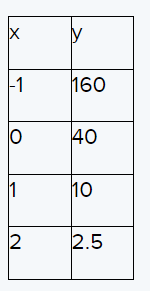
- Calculate the percentage change in y from x = −1 to x = 0.
- Calculate the percentage change in y from x=0 to x = 1.
- Calculate the percentage change in y from x = 1 to x = 2.
- Determine if the function represents exponential growth or decay based on the percentage changes.
- State the percentage rate of decay.
Answer:
We have to check using the given table whether the given function is an exponential growth or decay function:

If the value increases/decreases by a constant percentage it will be a exponential growth/decay function respectively.
From x = −1 to x = 0
The value of y changes from 160 to 40
The percentage change is :
P = \(\frac{40-160}{160} \times 100\)
we get percentage change as −75 %
From x = 0to x = 1
The value of y changes from 40 to 10
The percentage change is:
P = \(\frac{10-40}{40} \times 100\)
We get percentage change as −75 %
From x = 1 to x = 2
The value of y changes from 10 to 2.5
The percentage change is :
P = \(\frac{2.5-10}{10} \times 100\)
The percentage change is − 75 %
Since the percentage change is constant and is in negative the function is an exponential decay function.
The function is an exponential decay function according to the given table and the percentage rate of decay is 75 %
